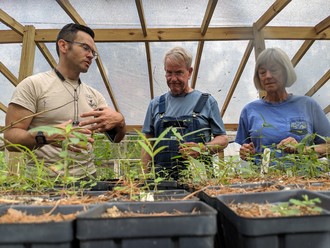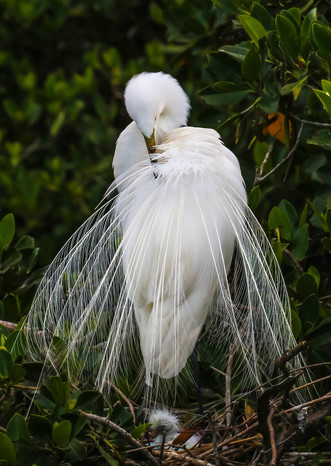 USFWS Ranger Scott Davis and volunteers removed weeds from hundreds of tiny native milkweeds, which will be planted across Florida to help monarch butterfly populations.
Last month we had the pleasure of lending a helping hand with the milkweed restoration initiative at St. Marks National Wildlife Refuge in Wakulla County. Along with a team of dedicated volunteers who sometimes refer to themselves as the “Milkweed Mafia,” we scrubbed pots, weeded beds of seedlings, and filled trays with soil that would soon hold precious milkweed seeds collected from the wild. Milkweeds are the host plant for our beloved monarch butterfly, whose caterpillars have co-evolved with the plant. One of milkweed’s defenses against predation is a toxic chemical compound produced within its leaves to deter herbivores. Monarch caterpillars, however, can consume the leaves and the toxin safely, which makes them taste terribly bitter to would-be predators who quickly learn to avoid these brightly-striped little larvae.
U.S. Fish and Wildlife Service Ranger Scott Davis has been working on the milkweed restoration initiative since 2015, when he started out with a single greenhouse table of seedlings. Since then he has been scouring the state for native milkweed populations and bringing seeds back to the refuge to propagate. He estimates that 300,000 plants have been grown here, which have been planted as part of restoration projects at state parks, state forests and national wildlife refuges across the state. It is no easy task to grow these plants, either. Of the 21 species of milkweed native to Florida, only a handful readily take to being grown in nurseries or backyard gardens. In one of the raised beds outside the greenhouse, sandhill milkweed (Asclepias humistrata) - one of the trickier species to plant - is growing successfully, but it was difficult to spot at first. This species grows best in sandy soils like those found in scrub and sandhill habitat, and seedlings grow best when they are near other native plants. Scott knelt down and searched under the clumps of native grass, and sure enough, the small milkweeds with their characteristic pale-pink leaf veins were visible underneath. This planting method isn’t practical for large-scale nursery propagation however, so Scott and his team are researching different soil mixtures that can be used to grow these plants from seed more easily and efficiently. Sure enough, inside the greenhouse, tiny humistrata are peeking out of flats of soil, reaching up towards the sun.
If it is so tricky to grow these native milkweeds, then why are we going to all the trouble of raising them? The answer lies in the importance of biodiversity. As Scott told us, “Without a diversity of different milkweed species, you only have one species here that can grow in a wetland or another species here that can grow in an upland; you need to have both. Also, typically as one milkweed species is going down for the year another species is emerging.” This diversity of milkweeds creates a connected patchwork of viable host species across the landscape and across the seasons, which is particularly important for monarchs as they complete their annual migration from Mexico to Canada and back.
We also learned that milkweed isn’t the only key to a successful monarch lifecycle. “People tend to plant wildflowers and no larval host species, or vice versa. You need food for the juveniles and you need food for the adults,” said Scott as he gestured to a bed of native wildflowers with ample nectar to support adult butterflies. They aren’t just important to monarchs but serve as an important resource to pollinator species, and by proxy to us. As Scott told us, “We’re very lucky that these insects, as they pollinate their favorite flower species, also like to go hang out on our vegetables and fruit trees. A lot of people don’t realize that when your vegetables and fruit trees are done flowering, their pollinators are not going to be able to hang around until the following year to take care of your plants again unless you have other plants flowering.”
This incredible program would not be possible without the support of dedicated volunteers, whose passion for this project shone through as they carefully weeded around the tiny milkweed plants and diligently scrubbed pots. “It’s so sad to me that we’ve lost so much habitat, but the general public is becoming more aware of our natural pollinators and our urban greenspaces,” said Molly, a master gardener and refuge volunteer. “We want to be able to provide them native plants, so all of the research that Scott and his team are doing here is amazing.”
If you are interested in learning more about volunteering, you can visit the Friends of St. Marks National Wildlife Refuge volunteer page. And don’t forget to check out our Wings Over Florida listing recognition program as you learn more about our native butterfly species!
 Great Egret photo by Steve Olive
There is no doubt that the breeding plumage of the Great Egret is stunning. Unfortunately, in the late 1800s their beauty led to serious species declines as these birds and their smaller relative the Snowy Egret were killed in huge numbers to make fashionable ladies' hats.
Concerned about the possible loss of these beautiful species, two Boston women, Harriet Lawrence Hemenway and Minna B. Hall, began hosting tea parties in 1896 for wealthy Boston socialites to explain the plight of these birds. Nine hundred women joined in a boycott of the hats. In the same year, the women organized the Massachusetts Audubon Society, the first of many Audubon Societies that would soon be founded in other states. By organizing, educating and exerting pressure on lawmakers, these women were fundamental in helping pass legislation that would protect our birds. In 1918, Congress passed the Migratory Bird Treaty Act, which made it “unlawful at any time, by any means or in any manner, to pursue, hunt, take, capture, kill, attempt to take, capture, or kill, possess, offer for sale, sell, offer to barter, barter, offer to purchase, purchase, deliver for shipment, ship, export, or import [...] any migratory bird.” That extensive list of prohibited actions effectively shut down the plume trade!
Thanks to the efforts of these early conservationists, these birds are still common throughout their ranges. We are grateful that their gorgeous plumage is still displayed by the birds in their natural habitats, and not just molding and gathering dust on century-old hats.
 FWC photo
To celebrate World Migratory Bird Day last month, we had the pleasure of joining the Friends of St. Vincent National Wildlife Refuge to help lead a birding and nature walk on the island. Like many places along the Panhandle’s coast, this barrier island is an important stopover site for migratory birds to rest and refuel after their grueling journey across the Gulf of Mexico. The eBird list for the NWR boasts an impressive 214 species, including Gray-cheeked Thrush, Swallow-tailed Kite, Vermillion and Scissor-tailed Flycatcher, and 21 species of wood warbler. While we were slightly too late in the season to see most migrants, one eagle-eyed attendee spotted a Masked Booby, an incredibly rare sighting for the area! In addition to the birds, the island is important for sea turtles and to red wolves reintroduced as part of the red wolf recovery program. While it is unlikely that you will see the wolves, we spotted tracks of adults and pups in the sand!
Apart from its rich biodiversity and natural beauty, the island also has a fascinating history. The land itself was built up over time from sediment carried down the Apalachicola river, as evidenced by the topography of dunes and swales as you traverse the paths. Archaeological evidence shows that the island has been inhabited since 240 A.D., and observant visitors may find pieces of pottery amongst the stones and shells on the shoreline. The island has been used for everything from logging to cattle grazing to hunting of imported big game animals such as zebras and elands. In 1968, St. Vincent was designated as a National Wildlife Refuge for this important island to be preserved in perpetuity.
Due to the impact of Hurricane Michael, there are no visitor facilities available on the island. Trails are not well marked. Please prepare by downloading or printing a map, and be sure to bring sunscreen, bug spray, snacks, and plenty of water. During seasonal hunts, the NWR is closed to other uses; please call ahead or check online for dates and more information.
St. Vincent Island National Wildlife Refuge is only accessible by boat.
Boat Ramp: CR 30-B / Indian Pass Rd., Port St. Joe, 32456
Phone: 850-653-8808
Cost: Free
Hours: Daily, sunrise to sunset
Website
June 1 – 4: National Audubon Photography Awards Show (St. Augustine)
June 1 & 22: Scrub-Jay Trail Day Orientation (Clermont)
June 16 & 19: Anastasia State Park Guided Bird Walk (St. Augustine)
June 22: Scrub-Jay Trail Day (Clermont)
June 27: Breakfast with the Birds Lecture (Naples)
Check out the events page of our website for more events across the state!
Do you know about any other bird or wildlife-related events going on in Florida? Help spread the word by letting us know! Send in the times, dates, locations and contacts to wildlifeviewing@myfwc.com for posting on the Great Florida Birding and Wildlife Trail website.
Events must be related to birds or other wildlife and must be open to the public. Examples include interpretive programming, summer camps and family programs.
|